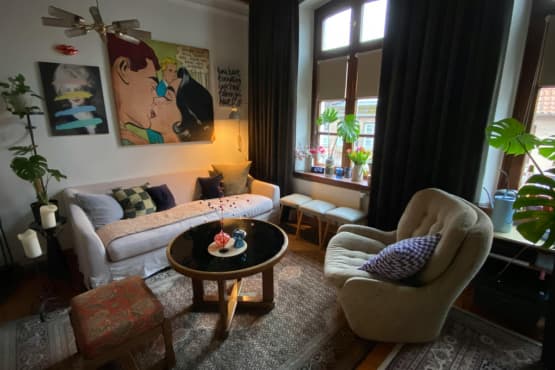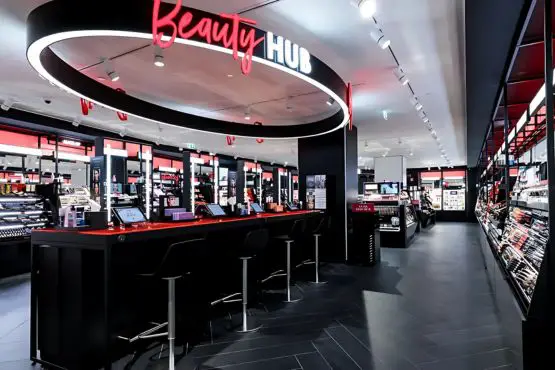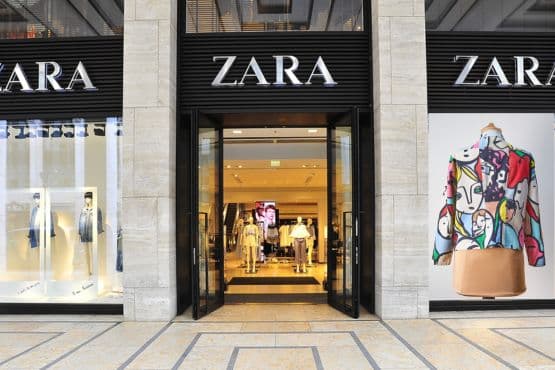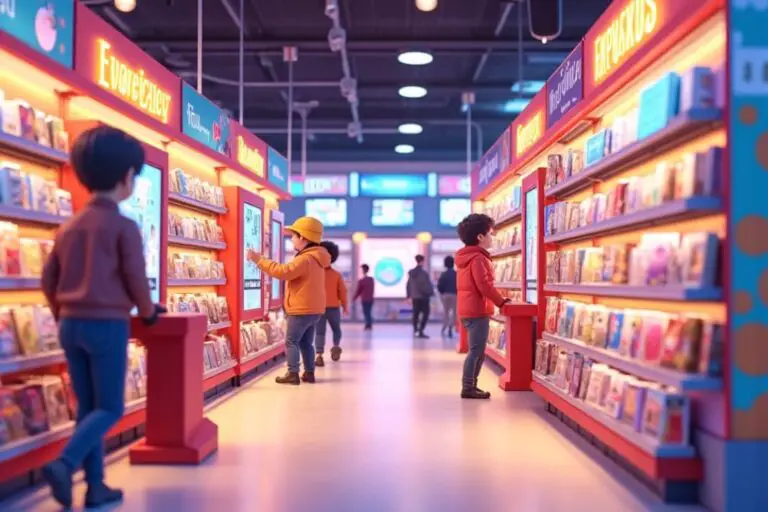In the dynamic world of retail, in-store displays serve as the silent but powerful salesforce, captivating customers and driving business success. As a seasoned expert in retail displays, I’ve witnessed firsthand the transformative impact of well-executed strategies. In this comprehensive guide, we’ll delve into the art and science of crafting displays that not only boost sales but also foster lasting customer engagement and brand loyalty. lets uncover In-Store Display Display Strategies in detail.
The Power of In-Store Displays
To understand the true potential of in-store displays, let’s turn to the merchandising strategies reflected in the numbers. A study by Brigham Young University found that strategically designed displays can increase sales by an astonishing 540% compared to unorganized presentations (Sorensen et al., 2017).
Furthermore, research by the Color Marketing Group reveals that effective color usage in displays can boost brand recognition by up to 80% (Color Marketing Group, 2019).
But the impact of in-store displays extends beyond immediate sales. The Point of Purchase Advertising International (POPAI) reports that in-store displays have a 10% higher recall rate compared to digital advertisements (POPAI, 2020).
This means that by creating memorable in-store experiences, you’re not only driving short-term sales but also building long-term brand awareness and customer loyalty.
Real-World Success Stories
Theory is essential, but real-world examples bring the power of in-store displays to life.
Let’s take a closer look at two retail giants that have mastered the art of display optimization:

- IKEA: The Swedish furniture retailer is renowned for its immersive showroom displays. By creating fully furnished room setups, IKEA allows customers to visualize how products would look and function in their own homes. This strategy not only inspires customers but also encourages them to purchase multiple items to recreate the look using effective merchandising strategies. According to Forbes, IKEA’s showroom displays contribute to an average customer spend of $60 per visit, showcasing effective store layout strategies .
- Sephora: The beauty retailer has revolutionized the in-store experience through interactive displays. Sephora’s “Beauty Hub” features digital screens that offer personalized product recommendations based on customer preferences. The displays also include virtual try-on technology, allowing customers to experiment with different makeup looks. This immersive experience has led to a reported 11% increase in sales and a 5% boost in customer loyalty.

These success stories demonstrate the tangible impact of well-executed in-store displays. By creating engaging, immersive experiences, retailers can drive sales, build brand loyalty, and differentiate themselves in a crowded market.
Navigating Modern Display Challenges
While the potential of in-store displays is vast, retailers must also navigate the unique challenges of the modern retail landscape.
As e-commerce continues to grow, brick-and-mortar stores need to offer visual merchandising strategies that cannot be replicated online.
This means integrating digital elements into product displays to meet the expectations of tech-savvy consumers.
Moreover, sustainability has become a major concern for shoppers. According to a study by Nielsen, 73% of global consumers say they would change their consumption habits to reduce their environmental impact (Nielsen, 2019).
Retailers must therefore prioritize eco-friendly display materials and design practices to align with customer values.
The COVID-19 pandemic has also reshaped consumer behaviors and preferences. Displays must now accommodate social distancing measures and heightened hygiene concerns in retail stores.
Contactless interactions, such as QR codes that provide product information or virtual try-on experiences, have become increasingly important.
Mastering Display Fundamentals
To create impactful displays, retailers must first master the fundamentals of visual merchandising. Let’s explore some key principles and techniques:
Layout and Product Placement
The layout of your displays plays a crucial role in guiding customer behavior. By strategically placing high-margin products at eye level and using color blocking techniques, you can draw attention to priority items.
The “Rule of Three” is a popular principle in visual merchandising, suggesting that grouping products in threes creates a more appealing and memorable display .
Lighting and Ambiance
Lighting is not just a functional element but also a powerful tool for creating ambiance and highlighting products in retail store displays.
Consider using a mix of ambient, task, and accent lighting to create depth and dimension.
Spotlighting key products or using backlighting to create a halo effect can add drama and focus to your displays .
Storytelling and Themes
Effective displays tell a story and evoke emotions. By creating themed displays that align with your brand identity and resonate with your target audience, you can forge deeper connections with customers.
For example, a beach-themed display for summer products can transport customers to a vacation state of mind and inspire purchases .
Mapping the Customer Journey
To optimize your displays, it’s essential to understand and cater to the customer journey.
By analyzing traffic flow patterns and identifying high-traffic areas, you can strategically place displays for maximum impact.
Heat mapping technology can provide valuable insights into customer behavior and dwell time, enabling data-driven placement decisions for product displays .
Consider how your displays guide customers through the store, encouraging exploration and discovery.
By placing complementary products together and creating cross-merchandising opportunities, you can increase average basket size and drive impulse purchases.
For instance, displaying a coordinated outfit alongside accessories can inspire customers to purchase the complete look.
Embracing Interactive Innovations
In the digital age, interactive displays have become a game-changer for retail. By incorporating technologies like augmented reality (AR) and virtual reality (VR), you can create immersive experiences that blur the lines between the physical and digital worlds.
Let’s explore some examples:

- ZARA’s store design incorporates various types of retail displays to enhance customer experience. The fashion retailer has implemented AR product displays that allow customers to virtually try on clothes and accessories. By scanning a QR code, customers can see how an item would look on them, increasing dwell time and driving sales.
- Sephora: The beauty brand offers virtual makeup tutorials and product recommendations through interactive screens. By leveraging customer data, Sephora can tailor displays to individual preferences, enhancing the shopping experience and building brand loyalty .
Seasonal Strategies and Storytelling
Effective in-store displays must adapt to the ever-changing seasons and holidays. By creating seasonal displays that align with cultural nuances and local traditions, you can create a sense of relevance and urgency for your customers. Here are some tips for successful seasonal displays:
- Plan ahead: Develop a seasonal calendar that outlines key dates and themes, allowing ample time for design and execution.
- Tell a story: Use your displays to narrate a cohesive brand story that resonates with the season or holiday. Incorporate elements that evoke emotions and create a sense of nostalgia or excitement in your window display.
- Balance tradition and innovation: While respecting traditional elements, don’t be afraid to add fresh twists to your seasonal displays. Incorporate trendy colors, interactive elements, or unexpected product pairings to surprise and delight customers.
Measuring Display Effectiveness
To continually optimize your in-store displays, it’s crucial to track and measure their performance. Here are some key metrics and methods to consider:
- Sales data: Compare sales figures for products featured in window displays versus those that are not. Look for trends and patterns that indicate the impact of your displays on purchase behavior.
- Dwell time: Use video analytics or heat mapping technology to measure how long customers engage with your displays. Longer dwell times suggest higher engagement and interest in certain products.
- Conversion rates can be significantly impacted by the effectiveness of various types of retail displays. Track the percentage of customers who make a purchase after interacting with a display. High conversion rates indicate effective displays that drive sales.
- Customer feedback: Gather feedback from customers through surveys, focus groups, or social media sentiment analysis. Understand what resonates with them and identify areas for improvement.
Conclusion and Next Steps
In-store displays are a powerful tool for driving sales, engagement, and brand loyalty. By combining timeless visual merchandising strategies with cutting-edge innovations, retailers can create immersive experiences that captivate customers and differentiate their brand.
As you embark on your journey to optimize your in-store displays, remember to:
- Prioritize customer-centricity: Understand your target audience and tailor your displays to their preferences and behaviors.
- Embrace technology: Incorporate interactive elements and digital innovations to create seamless, omnichannel experiences.
- Measure and iterate: Continuously track the performance of your displays and make data-driven decisions to refine your strategies.
- Stay agile: Adapt to changing consumer behaviors, seasonal trends, and industry developments to stay relevant and competitive.
By mastering the art and science of In-Store Display Display Strategies, you can unlock the full potential of your retail space and create memorable experiences that drive business success.
Ready to take your displays to the next level? Contact us for expert consulting services or download our free guide on in-store display optimization. Together, let’s create retail experiences that inspire, engage, and convert.




